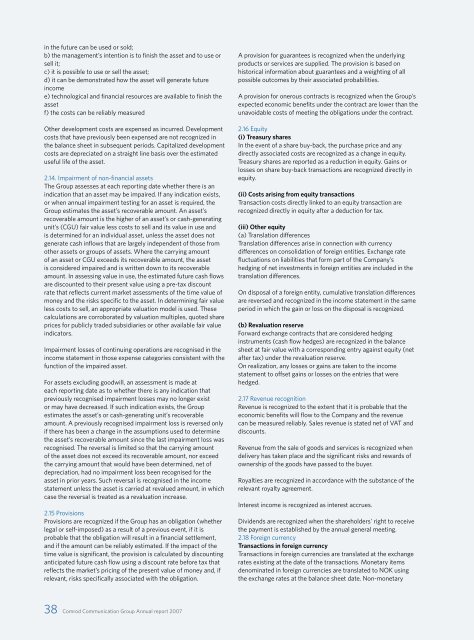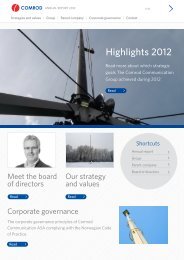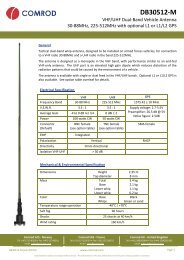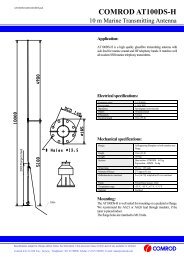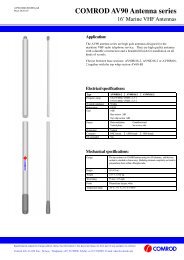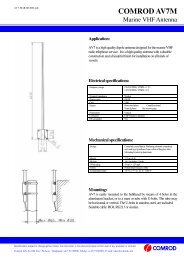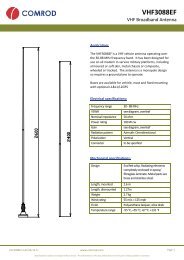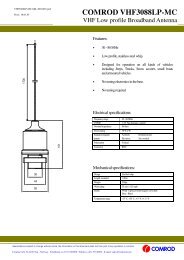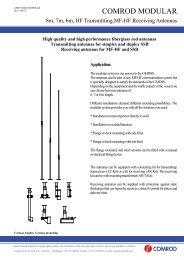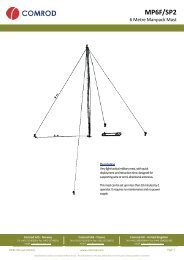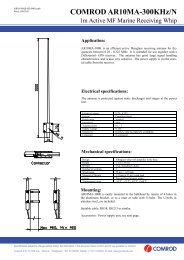in the future can be used or sold;b) the management’s intention is to finish the asset and to use orsell it;c) it is possible to use or sell the asset;d) it can be demonstrated how the asset will generate futureincomee) technological and financial resources are available to finish theassetf) the costs can be reliably measuredOther development costs are expensed as incurred. Developmentcosts that have previously been expensed are not recognized inthe balance sheet in subsequent periods. Capitalized developmentcosts are depreciated on a straight line basis over the estimateduseful life of the asset.2.14. Impairment of non-financial assetsThe Group assesses at each <strong>report</strong>ing date whether there is anindication that an asset may be impaired. If any indication exists,or when annual impairment testing for an asset is required, theGroup estimates the asset’s recoverable amount. An asset’srecoverable amount is the higher of an asset’s or cash-generatingunit’s (CGU) fair value less costs to sell and its value in use andis determined for an individual asset, unless the asset does notgenerate cash inflows that are largely independent of those fromother assets or groups of assets. Where the carrying amountof an asset or CGU exceeds its recoverable amount, the assetis considered impaired and is written down to its recoverableamount. In assessing value in use, the estimated future cash flowsare discounted to their present value using a pre-tax discountrate that reflects current market assessments of the time value ofmoney and the risks specific to the asset. In determining fair valueless costs to sell, an appropriate valuation model is used. Thesecalculations are corroborated by valuation multiples, quoted shareprices for publicly traded subsidiaries or other available fair valueindicators.Impairment losses of continuing operations are recognised in theincome statement in those expense categories consistent with thefunction of the impaired asset.For assets excluding goodwill, an assessment is made ateach <strong>report</strong>ing date as to whether there is any indication thatpreviously recognised impairment losses may no longer existor may have decreased. If such indication exists, the Groupestimates the asset’s or cash-generating unit’s recoverableamount. A previously recognised impairment loss is reversed onlyif there has been a change in the assumptions used to determinethe asset’s recoverable amount since the last impairment loss wasrecognised. The reversal is limited so that the carrying amountof the asset does not exceed its recoverable amount, nor exceedthe carrying amount that would have been determined, net ofdepreciation, had no impairment loss been recognised for theasset in prior years. Such reversal is recognised in the incomestatement unless the asset is carried at revalued amount, in whichcase the reversal is treated as a revaluation increase.2.15 ProvisionsProvisions are recognized if the Group has an obligation (whetherlegal or self-imposed) as a result of a previous event, if it isprobable that the obligation will result in a financial settlement,and if the amount can be reliably estimated. If the impact of thetime value is significant, the provision is calculated by discountinganticipated future cash flow using a discount rate before tax thatreflects the market’s pricing of the present value of money and, ifrelevant, risks specifically associated with the obligation.A provision for guarantees is recognized when the underlyingproducts or services are supplied. The provision is based onhistorical information about guarantees and a weighting of allpossible outcomes by their associated probabilities.A provision for onerous contracts is recognized when the Group’sexpected economic benefits under the contract are lower than theunavoidable costs of meeting the obligations under the contract.2.16 Equity(i) Treasury sharesIn the event of a share buy-back, the purchase price and anydirectly associated costs are recognized as a change in equity.Treasury shares are <strong>report</strong>ed as a reduction in equity. Gains orlosses on share buy-back transactions are recognized directly inequity.(ii) Costs arising from equity transactionsTransaction costs directly linked to an equity transaction arerecognized directly in equity after a deduction for tax.(iii) Other equity(a) Translation differencesTranslation differences arise in connection with currencydifferences on consolidation of foreign entities. Exchange ratefluctuations on liabilities that form part of the Company’shedging of net investments in foreign entities are included in thetranslation differences.On disposal of a foreign entity, cumulative translation differencesare reversed and recognized in the income statement in the sameperiod in which the gain or loss on the disposal is recognized.(b) Revaluation reserveForward exchange contracts that are considered hedginginstruments (cash flow hedges) are recognized in the balancesheet at fair value with a corresponding entry against equity (netafter tax) under the revaluation reserve.On realization, any losses or gains are taken to the incomestatement to offset gains or losses on the entries that werehedged.2.17 Revenue recognitionRevenue is recognized to the extent that it is probable that theeconomic benefits will flow to the Company and the revenuecan be measured reliably. Sales revenue is stated net of VAT anddiscounts.Revenue from the sale of goods and services is recognized whendelivery has taken place and the significant risks and rewards ofownership of the goods have passed to the buyer.Royalties are recognized in accordance with the substance of therelevant royalty agreement.Interest income is recognized as interest accrues.Dividends are recognized when the shareholders’ right to receivethe payment is established by the annual general meeting.2.18 Foreign currencyTransactions in foreign currencyTransactions in foreign currencies are translated at the exchangerates existing at the date of the transactions. Monetary itemsdenominated in foreign currencies are translated to NOK usingthe exchange rates at the balance sheet date. Non-monetary38 <strong>Comrod</strong> Communication Group <strong>Annual</strong> <strong>report</strong> 2007
items that are measured in terms of historical cost in a foreigncurrency are translated to NOK using the exchange rates at thedates of the transaction. Non-monetary items measured at fairvalue in a foreign currency are translated using the exchangerates at the date when the fair value was determined. Exchangedifferences are recognized in the income statement in the periodin which they arise.Foreign entitiesAssets and liabilities at foreign entities with a functional currencythat differs from the presentation currency are converted intoNorwegian kroner using the exchange rate in the balance sheetdate. Income and expenses from foreign entities are convertedinto Norwegian kroner using the weighted average exchange rate(if the average does not provide a reasonable estimate of thecumulative effects of using the transaction rate, the transactionrate is used). Exchange differences are recognized directly inequity.Translation differences arising from the conversion of netinvestments in foreign entities, and from related hedginginstruments, are specified as translation differences in equity.Translation differences in equity are taken to the incomestatement on the disposal of the foreign operations.2.19 Employee benefitsDefined benefit pension plansThe Group’s Norwegian companies offer their employees definedbenefit pension plans. The defined benefit liability is the net totalof the discounted value of future pension benefits accrued atthe balance sheet date, minus the fair value of plan assets. Thediscount rate is equivalent to interest on a 10-year governmentbond plus an additional amount to take into consideration thebond’s term to maturity. The valuation is carried out by a qualifiedactuary and the benefits are attributed using the projected unitcredit method.There are different schemes for the various group companies.Pension benefits are dependent on age, length of service andsalary. The net retirement benefit expense for the period (grossexpense less estimated return on pension assets) is includedin the item Payroll & social security expenses. Employer’scontributions are included in the figures and are calculated on thebasis of the gross retirement benefit liability.All of the Group’s employees at Norwegian companies arecovered by the early retirement programme (AFP) throughThe Norwegian Confederation of Trade Unions (LO)/TheConfederation of Norwegian Enterprise (NHO).The scheme is based on the standard requirements and termsof the LO/NHO scheme. The AFP program is treated as adefined benefit pension scheme. The scheme involves providingretirement benefits to employees who wish to cut down on workbefore reaching the retirement age for the Norwegian nationalinsurance scheme (age of 67). Employees can freely choosewhen to start drawing benefits between the ages of 62 and 67. Inorder to meet the requirements for AFP, the employee must haveworked at the Group for the past three years or have been coveredby the scheme for the past five years and have ten qualifying yearsfor the national insurance scheme after the age of 50. In additionto an annual premium related to the employee’s length of service,The Group also pays 25% of the individual’s pension benefits.Between the ages of 62 and 64, the whole pension is paid outof the AFP scheme, financed through the premium and the 25%paid by the Company. After reaching the age of 64, the state pays40% of the pension benefits due under the AFP scheme. Thecalculation of estimated AFP liabilities is carried out by a qualifiedactuary, and the benefits are attributed using the projected unitcredit method.Any introduction of a new defined benefit plan or an improvementto the present plan will involve changes to pension liabilities.These are recognized as an expense on a straight-line basisuntil the effect of the change has been accommodated. Theintroduction of new plans or changes to existing plans which takeplace retrospectively, thereby qualifying employees for a freepolicy (or change to a free policy), are recognized immediately.Gains or losses on the curtailment or settlement of pensionplans are recognized when the curtailment or settlement occurs.Actuarial gains or losses are recognized directly in equity (netafter tax).The Group’s companies in France have obligations relating totermination benefits for employees. Liabilities are calculated onthe basis of assumptions as length of service, discount rates,salary increases and retirement age. Allowance is made for socialsecurity costs related to the scheme.Share-based paymentsSenior executives in the Group have received options to subscribefor shares in the parent company. The fair value of the shareoptions is measured at the grant date and the cost is recognizedin the income statement, together with a corresponding increasein other paid-in capital, over the period in which the performanceand/or service conditions are fulfilled. The fair value is calculatedusing a Black & Scholes model.2.20 Government grantsGovernment grants, including the SkatteFUNN tax incentivescheme, are recognized when there is reasonable assurance thatthe Group will comply with the incentive conditions attaching tothem, and that the grants will be received. Grants are entered asdeductions against the expense that the grant is intended to cover.Grants relating to assets are capitalized and recognized as incomeon a systematic basis over the useful life of the asset. Investmentgrants are recognized as a reduction of the purchase price.2.21 TaxesCurrent income taxCurrent income tax assets and liabilities for the current and priorperiods are measured at the amount expected to be recoveredfrom or paid to the taxation authorities. The tax rates and taxlaws used to compute the amount are those that are enacted orsubstantively enacted by the balance sheet date.Current income tax relating to items recognised directly in equityis recognised in equity and not in the income statement.Deferred income taxDeferred income tax is provided using the liability method ontemporary differences at the balance sheet date between thetax bases of assets and liabilities and their carrying amounts forfinancial <strong>report</strong>ing purposes.Deferred income tax liabilities are recognised for all taxabletemporary differences, except:- where the deferred income tax liability arises from the initialrecognition of goodwill or of an asset or liability in a transactionthat is not a business combination and, at the time of thetransaction, affects neither the accounting profit nor taxable profitor loss; and- in respect of taxable temporary differences associated withinvestments in subsidiaries, associates and interests in joint<strong>Comrod</strong> Communication Group <strong>Annual</strong> <strong>report</strong> 2007 39


